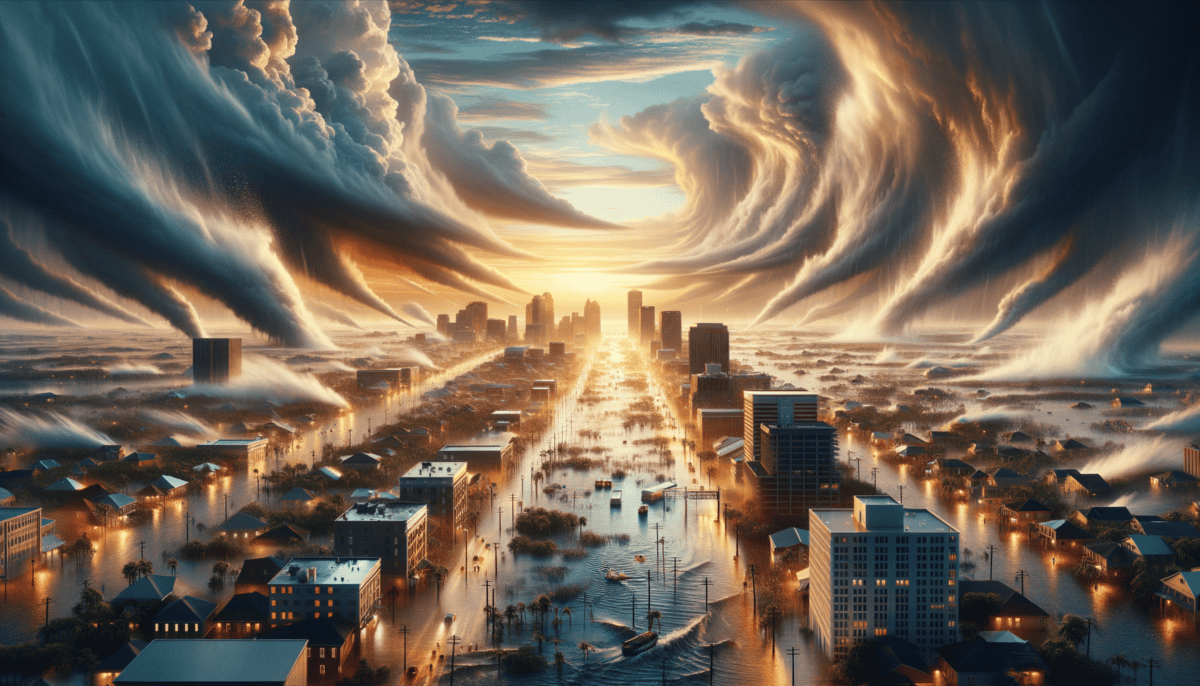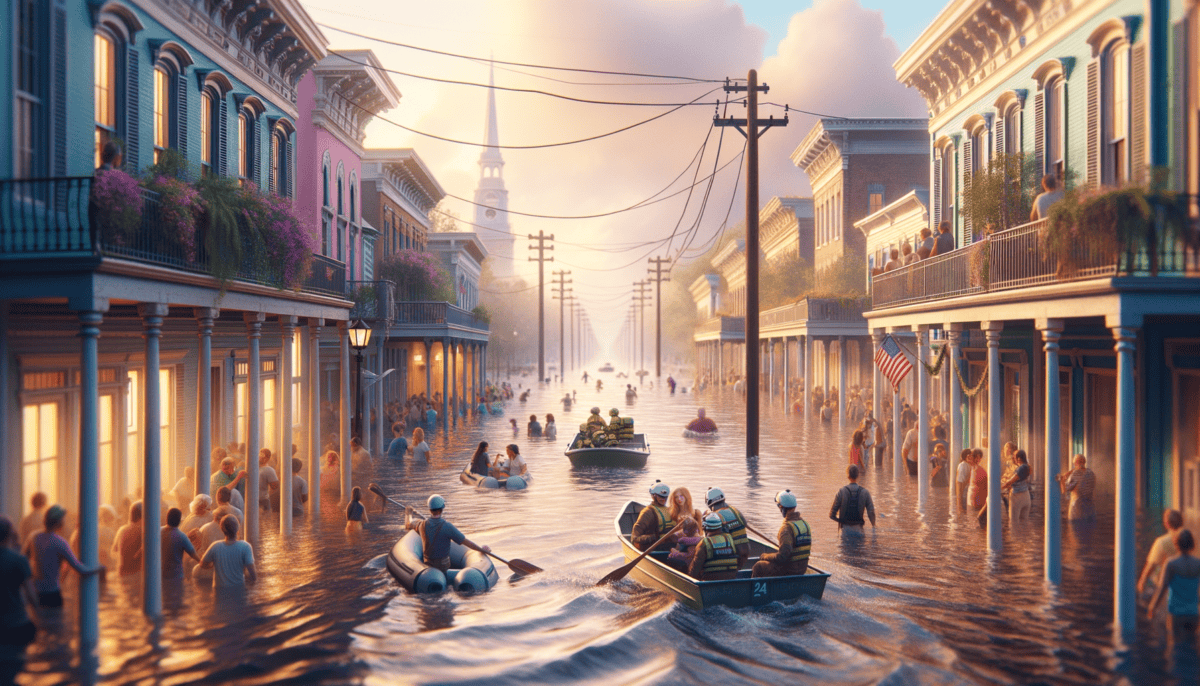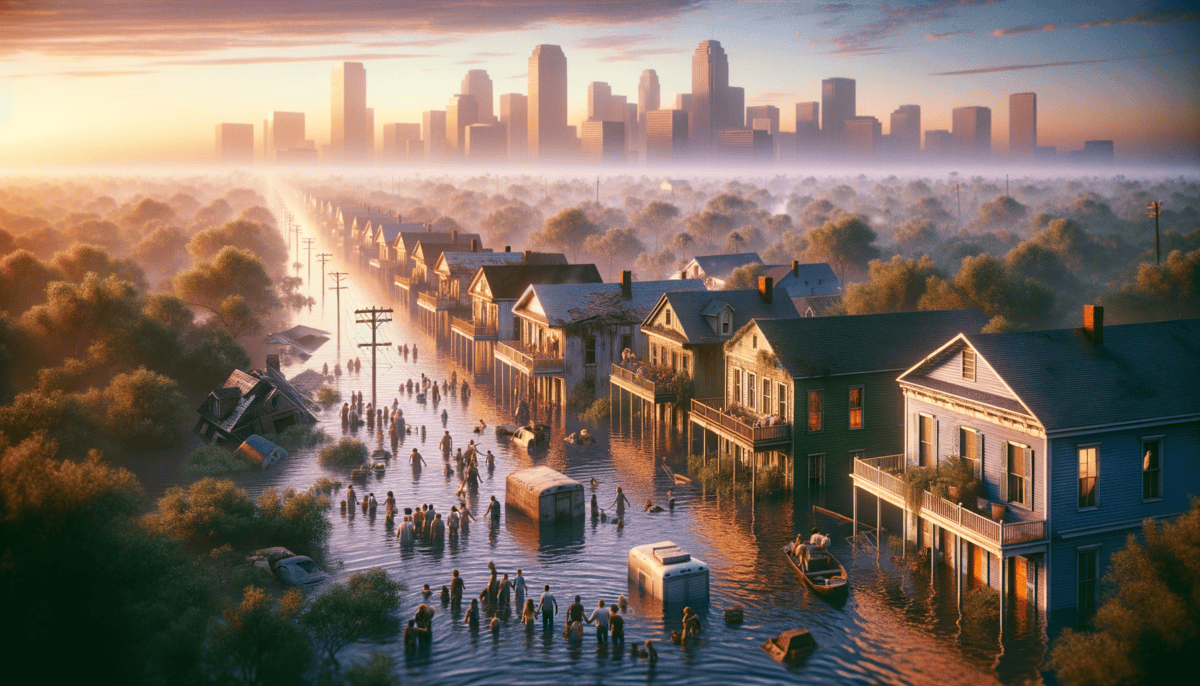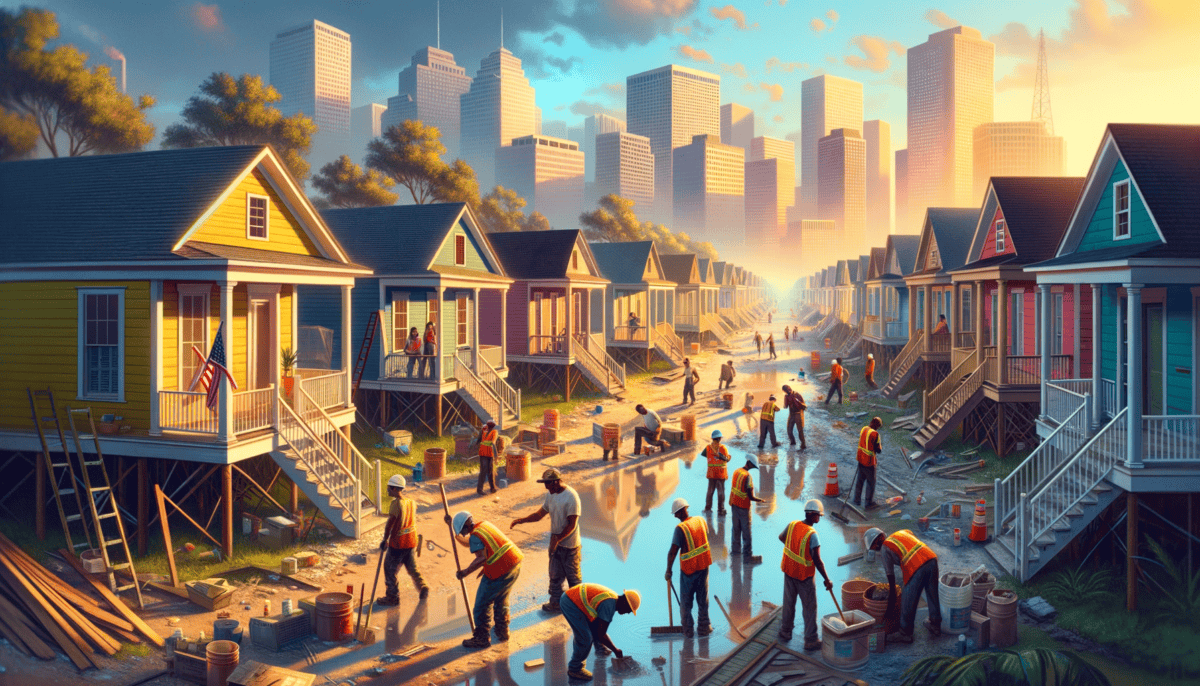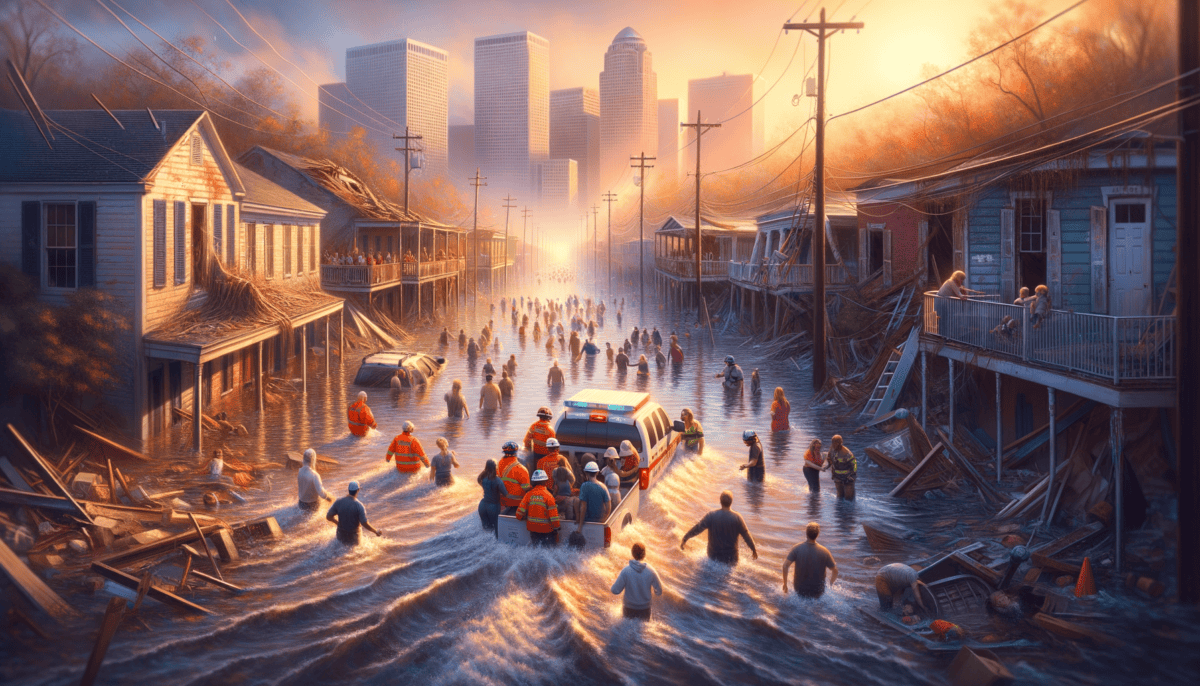The Brewing Storm
The sky turned dark over New Orleans. Little Sarah Jones looked up from her front porch, clutching her favorite teddy bear. Something was different about today. The air felt heavy and strange. ️
"Mama, why does the sky look so funny?" Sarah asked, tugging at her mother's sleeve.
Mrs. Jones gazed at the gathering clouds with worry in her eyes. "A big storm is coming, sweetie. We need to get ready."
New Orleans was special. It sat between a big lake and the mighty Mississippi River. But this also made it easy for floods to happen. Most of the city was lower than the water around it, like a bowl waiting to be filled.
The weather people on TV were very worried. A huge hurricane named Katrina was growing bigger and bigger in the warm waters of the Gulf of Mexico. It was spinning like a giant top, getting stronger every hour.
"Breaking News!" the TV announcer said. "Hurricane Katrina is now a Category 5 storm – the strongest kind there is!"
Sarah watched as her neighbors started getting ready. Mr. Thompson next door was putting boards on his windows. The Martinez family across the street was packing their car to leave town.
"What's a Category 5?" Sarah asked her dad as he brought water bottles inside.
"It means this storm is very strong," Dad explained. "Like five angry giants all at once."
The city leaders made an important announcement: "Everyone needs to leave New Orleans! This storm is too dangerous!"
Sarah helped her family pack their most important things:
- Photos and special memories
- Food and water
- Clothes and blankets
- First aid kit
- Sarah's teddy bear
The wind started to blow harder. Trees swayed back and forth like they were dancing. The radio kept playing warning messages about the hurricane. It was getting closer and closer to New Orleans.
"Will our house be okay?" Sarah whispered to her teddy bear as they got ready to leave.
Her mom hugged her tight. "We'll come back when the storm is over. The most important thing is that we're all safe together."
As they drove away, Sarah looked back at their house through the car window. The sky was getting darker, and she could hear thunder in the distance. Hurricane Katrina was coming, and it was going to change everything. ⛈️
Far out in the Gulf of Mexico, the massive storm spun like a giant washing machine. Its clouds stretched for hundreds of miles. Weather satellites showed it growing bigger and stronger with each passing hour.
The whole city held its breath. Everyone knew something big was about to happen. But nobody knew just how much Hurricane Katrina would change their lives forever.
The Moment of Impact
The morning of August 29, 2005, was unlike any other. The wind howled like a thousand wolves. Trees bent sideways as if they were made of rubber. Hurricane Katrina had arrived. ️
“Hold on tight, everyone!” shouted Bobby Martinez from his grandma’s attic. His family had stayed behind to help Grandma, who couldn’t travel. The house shook like a leaf.
The rain wasn’t normal rain. It fell sideways and stung like tiny needles. The wind picked up cars and tossed them around like toys.
Bobby watched through a small window as the water started rising in the streets. First, it covered the sidewalks. Then it crept up to people’s front doors. Soon, the water was as high as a tall adult.
“Mira! Look!” Grandma pointed at the TV before the power went out. The news showed something terrible – the levees were breaking! These big walls that kept water out of the city were falling apart.
The water rushed in like a giant bathtub overflowing. Houses that had stood for hundreds of years were swept away. The mighty Mississippi River pushed back into the city it had lived next to for so long.
All across New Orleans, families huddled together:
- Some climbed onto their roofs
- Others waved for help from windows
- Many prayed for the storm to end
- Brave neighbors helped each other
- Pets and people looked for high ground
“We need to get to higher ground!” Bobby’s dad said. The water was rising faster now. They helped Grandma into their small boat, which they had kept just in case.
The city looked different underwater. Street signs poked out like lonely fishing poles. Cars floated by like rubber ducks. The water was dark and angry, full of things it had picked up along the way.
“Will we ever see our home again?” Bobby asked, holding his grandmother’s hand.
“Home isn’t just a building, mijito,” Grandma said softly. “Home is where we are together.”
The storm raged on. Buildings that had weathered a hundred hurricanes couldn’t stand against Katrina’s fury. The famous French Quarter, usually full of music and laughter, was silent except for the howling wind.
As night fell, thousands of people gathered in the Superdome – the city’s giant sports stadium. It was supposed to be safe there, but the roof started to peel off like the lid of a tin can. ️
The water kept rising. Soon, 80% of New Orleans was underwater. That means if you had five houses on your street, four of them would be flooded! The city that had danced to jazz for centuries was now conducting a different kind of symphony – one of survival.
Bobby and his family made it to a shelter, joining hundreds of others who had fled their homes. They were safe, but their city was forever changed. As the storm began to weaken, everyone knew that surviving Katrina was just the beginning of their story.
Survival and Rescue
The water was everywhere in New Orleans. People needed help fast! The Superdome, a big sports stadium, became a shelter for thousands. But it wasn’t ready for so many people. ️
“We need more water!” Sarah, a nurse, called out. She was helping people at the Superdome. “And blankets too!”
The air felt hot and sticky inside. Little kids cried. Older people needed medicine. Everyone was scared and tired.
• Coast Guard boats
• Helicopter pilots
• Neighbors with small boats
• Doctors and nurses ⚕️
• Police and firefighters ♀️
“Look! Up there!” Tommy shouted, pointing at the ceiling. A rescue helicopter was landing on the roof. People clapped and cheered. Help was coming!
Outside, brave people in small boats went house to house. They called these boats the “Cajun Navy.” Regular people became heroes that day.
“Over here!” Mr. Johnson waved from his roof. He had been stuck there for two days with his dog, Max. A small fishing boat came to save them both.
At the Convention Center, another big building, more people waited for help. It was hard to get food and water there. But people shared what they had:
“Here, take some of our crackers,” said Mrs. Williams to a mom with two small kids.
The streets had turned into rivers. Rescue boats had to be careful of things hiding under the water. Signs, cars, and trees could hurt their boats.
Some people were stuck in their attics. They used axes to cut holes in their roofs to escape. The Coast Guard dropped bright orange baskets to pull people up to safety.
“Hold on tight!” called a Coast Guard helper as he lifted a little girl into his helicopter. Her cat was tucked safely in her jacket.
All around the city, neighbors helped neighbors:
“My boat can take three more people!”
“We have extra food at our shelter!”
“Does anyone need medicine? We found some!”
At night, flashlights dotted the dark city like fireflies. Rescue workers didn’t stop, even when it was dark. They knew people needed help.
The radio crackled with messages:
“Family stuck at 423 Oak Street… Elderly couple needs rescue on Canal Street… Baby needs formula at the shelter…”
In the Superdome, Sarah the nurse smiled as she wrapped a bandage around a little boy’s arm. “You’re being so brave,” she told him.
“Will we get to go home soon?” he asked.
“Not yet, sweetie,” she said gently. “But lots of people are working hard to help us all.”
Day after day, more help arrived. Big trucks brought water and food. Buses came to take people to safer places. Scientists tested the water and air to keep people healthy.
The rescue wasn’t easy. Sometimes boats couldn’t get to people fast enough. The helpers felt sad when this happened. But they kept trying. They knew every person they saved was worth all their hard work.
As the waters slowly went down, people started counting how many were saved. The numbers were big – thousands and thousands of people! Each rescue was special. Each person had their own story to tell.
The city was hurt, but its people were strong. They helped each other when things were scary. They shared food when people were hungry. They gave hugs when people were sad. That’s what made New Orleans special – not its buildings, but its people. ❤️
Aftermath and Fear
The water stayed in New Orleans for weeks. Many homes were broken. Some people had to live far away from their city.
Maria looked at her old house through the car window. The water mark went up to the roof. Her favorite teddy bear was still inside.
“When can we go home, Mom?” Maria asked softly.
“Not for a while, sweetie. Our house needs lots of fixing first,” her mom replied, wiping away a tear.
• No clean water to drink
• Houses full of mud
• Broken streets and bridges
• No electricity
• Schools closed
People lived in different places while they waited. Some stayed with family. Others lived in trailers or hotels. Many missed their friends and neighbors.
“I found your cat!” shouted Joey, running down the street. Mr. Garcia’s orange cat had been missing for days. Happy tears rolled down Mr. Garcia’s face as he hugged his pet.
The government sent help, but it was slow. People got angry. They needed things right away:
“We need clean water!”
“Our children need schools!”
“Help us fix our homes!”
Scientists came to test the water and soil. The flood left behind yucky stuff that could make people sick. They wore special suits to stay safe.
Some good things happened too. People from all over the country sent help:
“Look at all these boxes!” Tommy said. “They’re full of new clothes and toys!”
Doctors set up special tents to help sick people. Teachers started classes in trailers. Stores opened in big tents. Life was different, but people tried to make it work. ⚕️
Every day, more people came home to check their houses. Some cried when they saw the damage. Others rolled up their sleeves and started cleaning.
“We can fix this,” said Mrs. Johnson, picking up a wet photo album. “We’re strong together.”
Big machines came to clear the streets. They moved broken cars and fallen trees. The sound of hammers filled the air as people fixed their homes.
Maps showed which parts of the city were safe to visit:
Green areas – Safe to go home
Pink areas – Not safe yet
Red areas – Very dangerous
People kept lists of missing friends and family. When they found each other, there were big hugs and happy tears.
“I missed you so much!” Sarah cried, hugging her grandmother. They hadn’t seen each other since the storm.
Animals needed help too. Kind people rescued pets left behind. They gave them food and found their families. Some pets had walked very far to find home.
The helpers worked hard every day:
“Another house cleaned out!” called the workers.
“The power is back on this street!” shouted the electrical workers.
“The water is safe to drink now!” announced the water testers.
Little by little, things got better. But it would take a long time for New Orleans to feel like home again. The city needed lots of love and care to heal.
Maria planted a small flower in front of her temporary home. “It’s not the same,” she said, “but we can make new pretty things while we wait.”
The spirit of New Orleans was still strong. Its people didn’t give up. They knew that together, they could rebuild their special city. They just needed time, help, and hope.
New Dreams Rising
Spring came to New Orleans. Green leaves popped up through the mud. People worked together to make their city better.
Maria and her family moved back to their street. Their house wasn’t fixed yet, but they lived in a small trailer nearby.
“Look, Mom!” Maria pointed excitedly. “Mr. Johnson is painting his house blue again!”
All around the city, people helped each other rebuild:
• Neighbors sharing tools
• Kids planting new trees
• Families cooking for workers
• Friends helping clean houses
• Teachers fixing schools
Sarah’s dad opened his restaurant again. It was smaller now, but the gumbo still tasted like home.
“First hot meal in our neighborhood!” he announced proudly. “Everyone come eat!”
The city made new plans to keep people safe. They built stronger walls to hold back water. Houses got built higher off the ground.
“We’re smarter now,” said the mayor. “We know how to protect our city better.”
Maria’s school opened in a new building. The walls were bright yellow, like sunshine. Her old friends came back one by one.
“I missed you so much!” Maria hugged her best friend Jenny.
The playground got new swings and slides. Children’s laughter filled the air again. Even the teachers smiled more.
Joey started a garden in his backyard. He gave vegetables to neighbors who needed food.
“My tomatoes are growing!” he shouted. “Who wants some?”
Artists painted bright pictures on broken walls. Musicians played jazz in the streets. Dancers twirled in parks. The city’s spirit danced back to life.
People held block parties to celebrate small wins:
“The whole street has power again!”
“All the kids are back in school!”
“The corner store is open!”
Scientists taught people about storms. They learned new ways to stay safe. Everyone kept emergency bags ready, just in case.
Maria’s mom got a new job helping fix houses. “We make them stronger now,” she said. “Like us.”
The zoo reopened with new baby animals. Parks got fresh grass and flowers. Trees grew tall again. Nature helped heal the city.
Tommy found his old basketball court cleaned up. “Who wants to play?” he called. Soon kids filled the court with happy shouts.
Some things changed forever. But new good things came too:
• Better storm warnings
• Stronger buildings
• Closer neighbors
Maria’s family finally moved back into their fixed house. It looked different, but felt like home.
“Our city is like a big quilt,” Grandma said. “Some pieces are old, some are new. But stitched together with love, it’s beautiful.”
Each week brought more progress. More families returned. More shops opened. More music played. New Orleans was growing stronger.
“We’re not just building houses,” said Mr. Garcia. “We’re building hope.”
At night, Maria looked out her window. The stars shone bright over her healing city. Tomorrow would bring more work, more help, more healing. But New Orleans was ready. Its people stood together, brave and strong.
A City Reborn
Ten years passed since Hurricane Katrina. Maria walked down her street, now lined with tall trees and colorful houses. She smiled at how far they had come.
“Remember when this was all underwater?” she asked her little brother Tommy, who was just a baby during the storm.
“Tell me the story again, Maria!” Tommy bounced excitedly.
Maria pointed to their bright blue house. “Our home flooded up to the roof. But look at it now!”
• Higher, stronger houses
• Better flood walls
• Smart warning systems
• Prepared communities
• Stronger spirit
Sarah’s dad’s restaurant was busy again. The smell of jambalaya filled the air.
“Best gumbo in town!” called Sarah, now helping her dad run the place.
Joey’s little garden had grown into a big community farm. People came from all over to grow food together.
“These vegetables taste better because we grew them with love,” Joey told the children who helped him plant.
Maria’s mom became a city planner. She helped make New Orleans safer:
“We learned from Katrina,” she explained. “Now we build smarter and stronger.”
The city looked different, but its heart stayed the same. Jazz music still played in the streets. People still danced on corners.
Mr. Johnson, now with gray hair, still sat on his blue porch:
“This city is like a phoenix,” he said. “We rose from the water, stronger than before.”
Scientists used New Orleans as an example. They showed how cities could prepare for big storms. Other places learned from what happened here.
Schools taught children about hurricanes and safety. Maria helped teach younger kids:
“Being ready helps us stay strong,” she told them. “Knowledge keeps us safe.”
The old playground where Maria once played was now a beautiful park. Children laughed on new swings while parents watched from shady benches.
Grandma’s quilt hung in the community center. It told Katrina’s story in fabric and thread:
“Every stitch shows our journey,” Grandma said. “From storm to strength.”
New Orleans became famous for its comeback. People visited to learn about hope and healing. They saw how a city could rise again. ⭐
“Our story helps others,” Maria said proudly. “That makes everything we went through mean something.”
The city celebrated Katrina’s anniversary differently now. Instead of remembering the storm, they celebrated their strength.
At the celebration, Maria saw old friends who helped during the hard times:
“We did it together,” they said, hugging and laughing. “We’re family now.”
Tommy looked up at his big sister. “Will another hurricane come?”
Maria squeezed his hand. “Maybe. But we’re ready now. We’re stronger. We know how to take care of each other.”
As the sun set, music filled the streets. People danced and sang. Children played. The city glowed with life and hope.
“New Orleans will always have storms,” Maria told Tommy. “But we’ll always have each other too. That’s what makes us special.”
The stars came out over their beloved city. They twinkled like promises in the night sky. Tomorrow would bring new challenges. But New Orleans would face them together, stronger and wiser than before.


